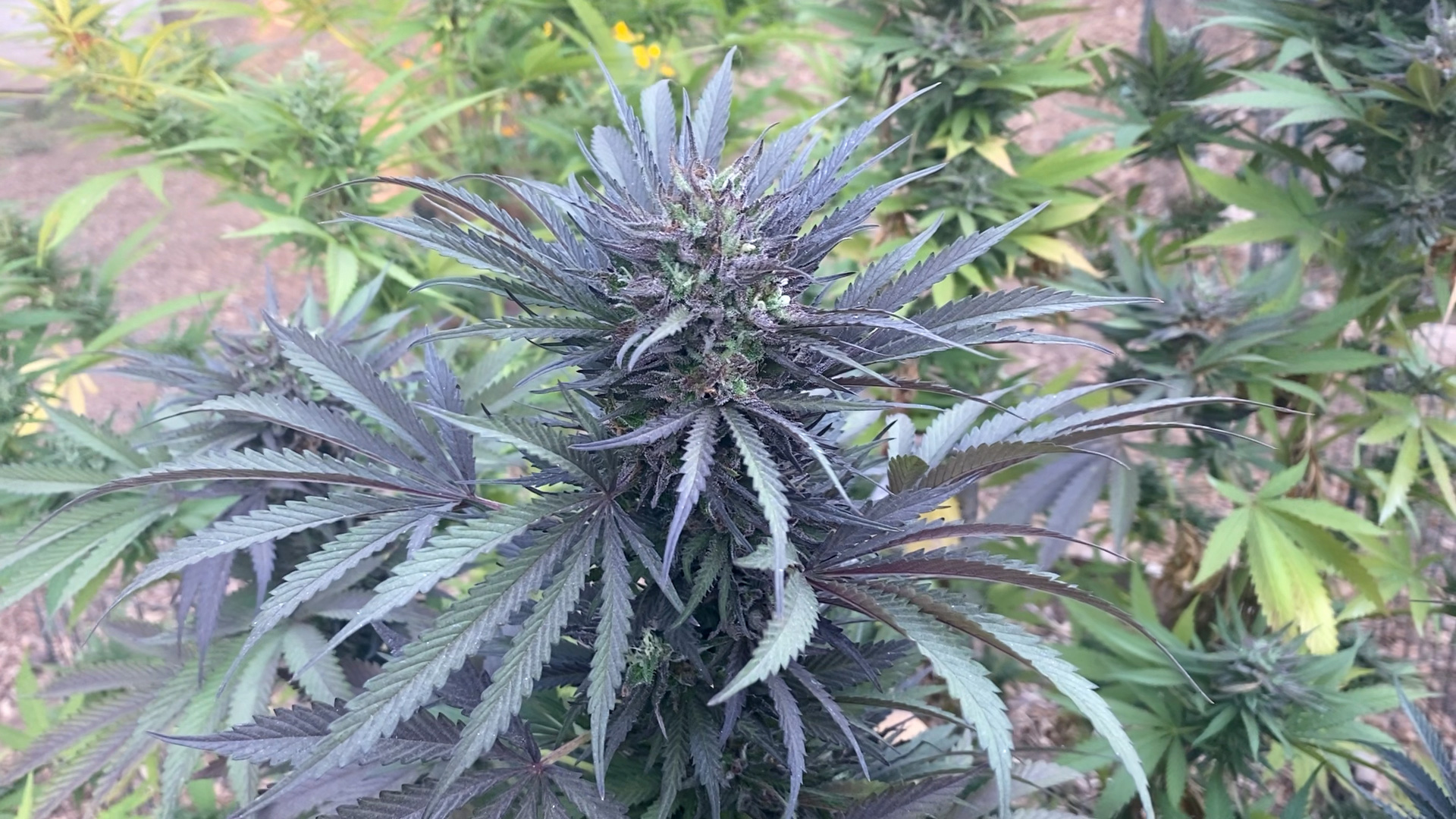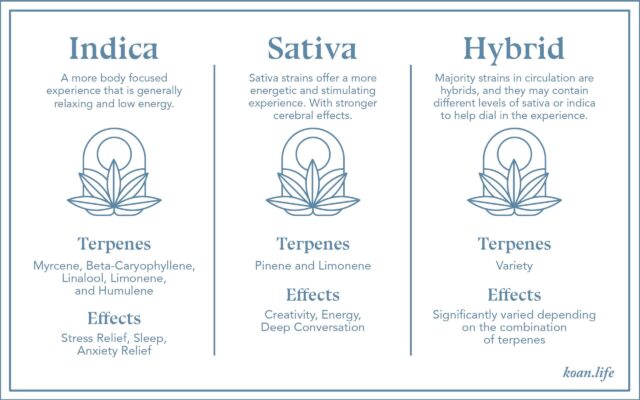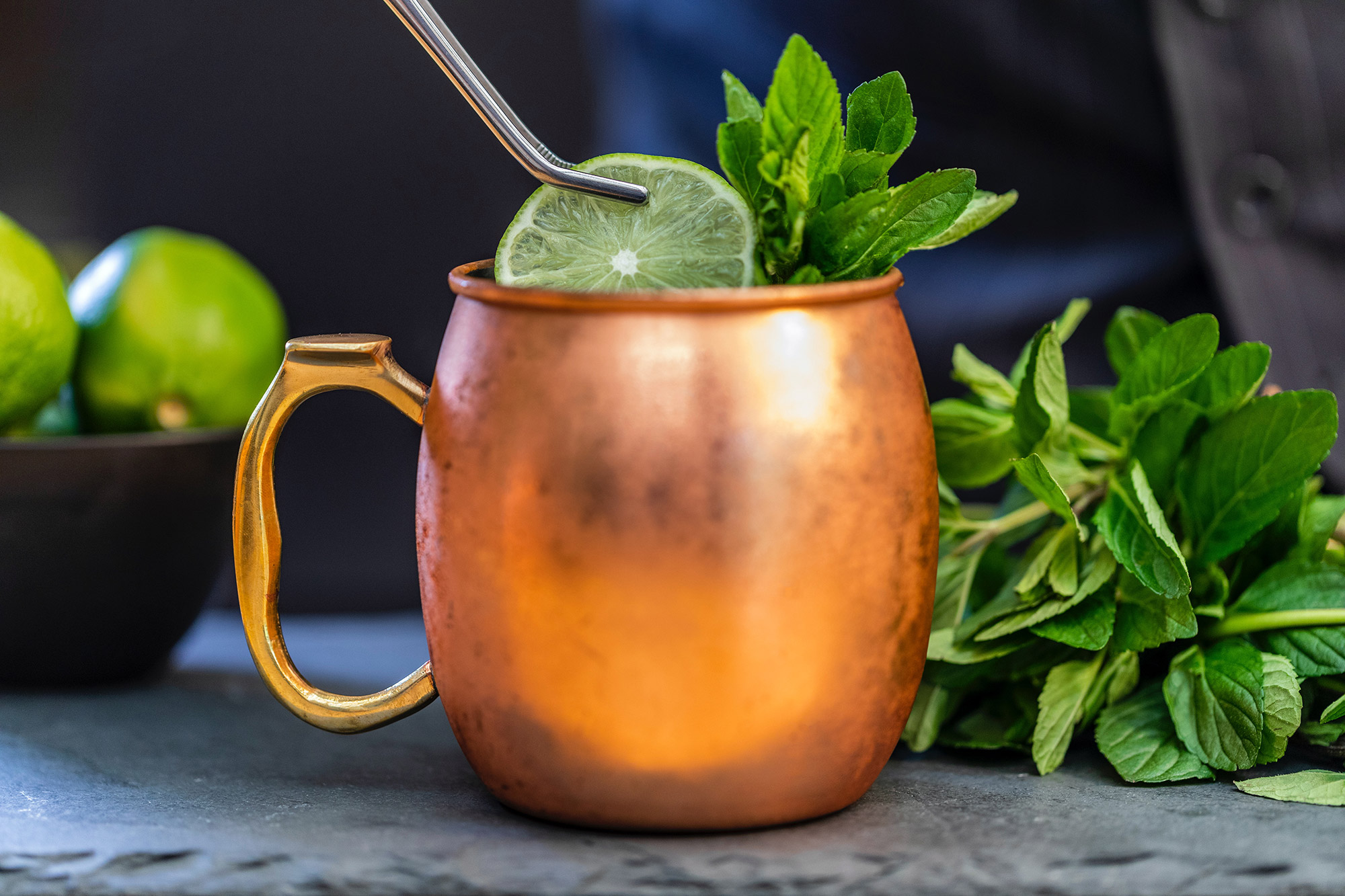Are We Still Comparing Indica vs. Sativa vs. Hybrid? – Try a Terpene Analysis Instead

The Age-Old Question – Indica? Sativa? Or Hybrid?
Chances are high that you’ve been in a situation at a licensed cannabis dispensary where you’ve barely stepped foot inside only to have a budtender hitting you with the classic question, “are you looking for an indica, sativa, or hybrid?”. If this hasn’t happened to you — yet — then surely, you’ve found yourself in conversation with friends, only to hear lines like: “Indicas are my favorite…they help me sleep”, “I’m a fan of sativas…they’re so uplifting!”, or “I want the best of both worlds, which is why I always buy hybrids”, all of which probably left you wondering if there’s actually any validity to all of this cannabis nomenclature.
The truth of the matter is that, while the creative strain names bestowed upon varieties of cannabis may somewhat convey an ideal of the effects one might expect from that variety, they’re not much more than colloquial marketing names that give dispensaries and producers the ability to distinguish between different genetic varieties of cannabis. As researchers continue to gather data and better understand the cannabis plant, the nuanced approach to labeling cannabis genetics with catchy strain names has unintentionally become a disservice to canna-consumers. Considering the wide array of cannabis genetic variations, the industry needed a way to distinguish to the consumer the different varieties available, hence why colloquial strain names became cultural commonplace.

As researchers have continued exploring the biology of cannabis, data has determined that these tongue-in-cheek names provide essentially no insight as to the cannabinoid and terpene composition of your specific product. In essence, strain names are sort of a “false shortcut” to representing a variety’s effects, the fallacy being held within the fact that these advertised effects are seldom delivered when based on a strain name.
Fortunately, scientists have also discovered a more accurate way to distinguish between cannabis varieties and the industry is rapidly adopting this new approach. That’s why we decided to take some time to provide you with the information needed to shed some light on how you purchase, use, and experience cannabis, all by one simple question that you can ask your budtender.
Why We Shouldn’t Ask for Indicas, Sativas, or Hybrids
There are several reasons why you should stop choosing your cannabis products based on sativa, indica, or hybrid delineations.
- Genetic Drift – This occurs when the pollen — which houses the plant’s genetics — spreads from one variety of cannabis to another. While it may sound like a problem with a simple solution, cannabis pollen is exceptionally robust in its ability to spread. For instance, a farmer growing only a single variety of cannabis could unknowingly experience cross-pollination — thus shared genetics — from a neighboring farm that is several miles away. Without testing each plant, large grow-ops don’t have access to technology yet to be able to — feasibly — determine if or when this happens.
- Genetic degradation – Cannabis, like all other living organisms, undergoes genetic variations from generation to generation. The speed at which these genetic variations are observable is expedited given the large-scale and industry practices of commercial cannabis agriculture. Genetic degradation occurs during a practice called propagation, where farmers take clippings from a mother plant to create new plants, referred to as clones. Although the cloned plants share the same genetics as the mother plant, there is a degree of degradation that occurs with each propagation cycle.
- Variable Growing Conditions – Just because a cannabis plant maintains the genetic potential to produce a certain composition of cannabinoids and terpenes, doesn’t mean that it necessarily will. Environmental and climatological variables like soil condition, nutrients, light exposure, weather, and harvest cycles are just a few of the countless variables that play a role in how capable a cannabis plant is of reaching its full genetic potential.
The same logic behind not selecting your cannabis based on colloquial terms like sativa, indica, or hybrid, also applies to choosing cannabis by strain names. In fact, the term strain doesn’t really make sense in the way that it is used in the cannabis community. Technically, a strain is nomenclature reserved to distinguish between different bacteria, viruses, and fungi. Ultimately, just because you’ve read online or heard from someone that a certain variety of cannabis will deliver specific effects, doesn’t mean that your product, even if it is the same variety, will produce matching results. Additionally, the use of strain names gives you no information regarding your product’s terpene profile. This old-school approach of strain names is quickly being replaced with the use of chemovars.
Chemovars – The New Way to Communicate with Your Budtender
The consensus these days is that cannabis should be labeled and marketed based on the genetics of a specific batch. As we have discovered, major cannabinoids like THC and CBD aren’t the only constituents of the cannabis plant that determines the effects. Minor cannabinoids like CBN and CBG as well as terpenes, the compounds that give cannabis varieties — and most other plants — their unique taste and aroma, are all components that affect the experience. In fact, a recent study published in Nature Plants, suggests that “cannabis labelling is associated with genetic variation in terpene [genetics] [5]”.
So how do we adjust our nomenclature to better represent cannabis varieties? You’ll likely hear the term chemovar — or chemotype — popping up more frequently as this is the latest method of solving the “what do we call this” debacle. Classifying cannabis by chemovars gives the user insight into the terpene profile of a specific variety. With this information, consumers will find themselves better equipped to identify a cannabis product that is more likely to deliver a predictable experience. If you would like to take a deeper dive into the world of chemotypes and chemovars, here is an excellent resource.
If you’re not comfortable using chemovar type classifications, there are still other means of making sure the cannabis product you choose is more likely to deliver your desired effects. One approach is communicating the terpene profile that you want in a product. This approach will require a little homework on your end to determine the terpenes you feel are best fit for you, but we have some excellent resources on terpenes to get you started. As you’ll discover, there are specific terpene recommendations based on the experience or effect that you’re seeking. For example, someone who uses cannabis to help with anxiety may ask for a product that contains linalool, a-bisabolol, or beta-caryophyllene.
The Golden Question – “Can you show me the terpene analysis for this product’s batch?”
This is one of the best approaches that a cannabis consumer can take to ensure their product is exactly what they expect. This is a question that most budtenders are becoming accustomed to hearing. In fact, many budtenders will be impressed that you’re using cannabis with an informed and guided approach. A terpene analysis can come in many forms and will most likely look like a certificate of analysis (COA) that you may have seen before — those are the lab documents that typically display metrics like lab-tested cannabinoid content.
The key items to look for when presented with a product’s terpene profile analysis are that the batch number on the document matches the batch number printed on your product and that the terpenes you’re searching for are noted as present for your product. If the batch number differs, it is likely that the COA doesn’t accurately represent your product. — Remember our discussion of product variation?
A circumstance that you’re likely to experience when asking for terpene profile lab results will be the budtender explaining that they weren’t provided a COA by the brand. This should be an immediate red flag for any cannabis consumer. Cannabis brands that aim for specific target effects should always be very transparent about the terpenes they’re using. A reputable brand that produces a quality cannabis product targeting a specific effect or experience typically wants to share product information like terpene profiles. This is because they recognize that terpenes are a key differentiator and generator of specific effects. Consumers should keep this in mind when shopping for cannabis.
If this is a new concept for you or you feel as though this is an information overload, don’t beat yourself up too much. A little practice and some trial and error will have you making informed decisions sooner than you may think. However, if you don’t want to complicate your relationship with cannabis by constantly scouring through COAs and terpene analysis documents, there is one other method to guarantee your product is consistently and accurately dosed each batch — precision dosed products.
Precision Dosed Products
Technological advancements combined with ingenuity and some proprietary methods have finally opened the doors for cannabis brands to confidently dose certain product types like cordials with not only cannabinoids, but terpenes too. Even better, this methodology also grants brands the ability to maintain this consistency from batch to batch, giving the user the ability to repeat experiences and effects, time after time.
Unfortunately, these precision dosing methods are limited to certain product types and as a consumer, a due diligence process that you’re comfortable with, should always be used. For most, this will include asking for a batch specific COA and terpene analysis, if you want to be 100% confident that you’re getting what you’re paying for.
Does it Really Matter if My Products are Consistently and Accurately Dosed as Long as I’m Getting Something?
It should! How would you feel if you discovered the pain reliever that you take for a headache may or may not actually contain the active ingredients that it claims? What if you were told that your favorite gas station doesn’t precisely measure the amount of fuel dispensed, but you’re still paying full price? Why should you treat cannabis products any differently? If you can’t inherently trust something that you’re putting into your body, then are you truly reaping all of the potential benefits?
Finding a cannabis brand and product line that provides an accurately and consistently dosed product is like searching for a needle in a haystack, but they’re out there. The difference it will make in your relationship with cannabis is beyond rewarding. If you’re looking for a jumping off point to make your quest for the perfect cannabis product a bit easier, then you may want to ask your dispensary if they carry Koan Cordials.

Koan is one of the cannabis brands leading the charge to change how cannabis is used as a tool. Their single-serving cordials are consistently dosed from batch to batch with laboratory precision. This gives consumers the ability to not only predict the effects of their cannabis use, but also opens the door for experiences that are repeatable. Along with eliminating the “here goes nothing” mindset of consuming cannabis products with variable ingredients, Koan Cordials also provide thorough and informative panels outlining the terpene content of their products. Available in several blends, these cannabis cordials put the control back into your hands, which allows you to choose your moment.
From blends crafted to entice your creative side to those designed to guide you on a deeper journey of enchantment, Koan Cordials provide users with the key to a sundry of journeys and routinely add more to their product line. If you find that your local dispensary has sold out of Koan Cordials and you’re a resident of California, you can now order them online and have your favorite blends delivered right to your front door. Be it with Koan or under the guidance of your own research, basing cannabis product choices not only on cannabinoid content, but terpene composition as well, will foster a renewed relationship with cannabis that facilitates a repeatedly surreal experience — Physically. Mentally. Emotionally.
This article is for informational purposes only and not to be used as medical advice. Please speak with a medical professional before making any changes to your diet, medications, or daily routine. These statements have not been evaluated by the FDA. These products are not intended to diagnose, treat, cure, or prevent any disease.
References:
- https://www.healthupp.com/why-you-should-buy-your-thc-and-cbd-products-at-a-licensed-dispensary/
- https://www.nature.com/articles/s41477-021-01003-y
- https://www.ncbi.nlm.nih.gov/pmc/articles/PMC5576603/
- https://www.ncbi.nlm.nih.gov/pmc/articles/PMC7480732/#:~:text=These%20varieties%20are%20called%20%E2%80%9Cstrains,used%20for%20bacteria%20or%20viruses.&text=The%20vast%20majority%20of%20commercially%20cultivated%20Cannabis%20plants%20are%20produced%20through%20cloning.
- https://www.nature.com/articles/s41477-021-01003-y
- https://cannigma.com/plant/cannabis-chemovars-chemotypes/



